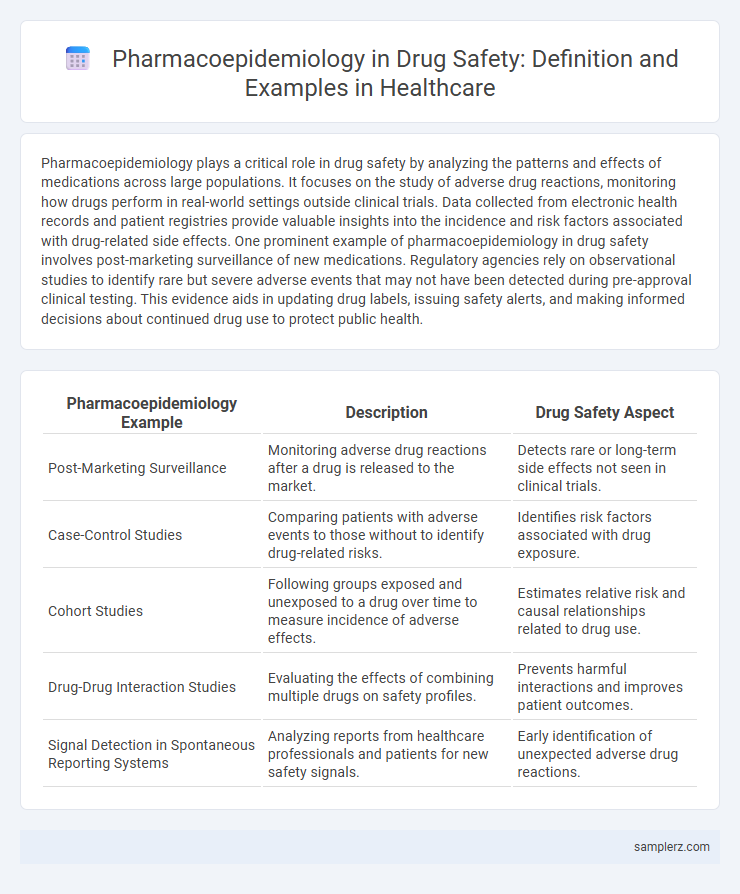Pharmacoepidemiology plays a critical role in drug safety by analyzing the patterns and effects of medications across large populations. It focuses on the study of adverse drug reactions, monitoring how drugs perform in real-world settings outside clinical trials. Data collected from electronic health records and patient registries provide valuable insights into the incidence and risk factors associated with drug-related side effects. One prominent example of pharmacoepidemiology in drug safety involves post-marketing surveillance of new medications. Regulatory agencies rely on observational studies to identify rare but severe adverse events that may not have been detected during pre-approval clinical testing. This evidence aids in updating drug labels, issuing safety alerts, and making informed decisions about continued drug use to protect public health.
Table of Comparison
| Pharmacoepidemiology Example | Description | Drug Safety Aspect |
|---|---|---|
| Post-Marketing Surveillance | Monitoring adverse drug reactions after a drug is released to the market. | Detects rare or long-term side effects not seen in clinical trials. |
| Case-Control Studies | Comparing patients with adverse events to those without to identify drug-related risks. | Identifies risk factors associated with drug exposure. |
| Cohort Studies | Following groups exposed and unexposed to a drug over time to measure incidence of adverse effects. | Estimates relative risk and causal relationships related to drug use. |
| Drug-Drug Interaction Studies | Evaluating the effects of combining multiple drugs on safety profiles. | Prevents harmful interactions and improves patient outcomes. |
| Signal Detection in Spontaneous Reporting Systems | Analyzing reports from healthcare professionals and patients for new safety signals. | Early identification of unexpected adverse drug reactions. |
Introduction to Pharmacoepidemiology in Drug Safety
Pharmacoepidemiology in drug safety involves studying the patterns, causes, and effects of medication usage within populations to identify adverse drug reactions and improve therapeutic outcomes. This discipline integrates clinical pharmacology with epidemiological methods to monitor post-marketing drug safety and assess risk-benefit profiles. Real-world data from electronic health records, registries, and spontaneous reporting systems provide critical insights for regulatory decisions and patient safety enhancements.
Key Concepts in Drug Safety Assessment
Pharmacoepidemiology in drug safety assessment involves evaluating adverse drug reactions (ADRs) and drug utilization patterns in large populations to identify potential risks. Key concepts include signal detection, risk-benefit analysis, and post-marketing surveillance, which help in monitoring drug safety after approval. These methods use real-world data to detect rare side effects and ensure continuous evaluation of drug efficacy and safety profiles.
Real-World Case Studies of Drug Safety Monitoring
Real-world case studies in pharmacoepidemiology have been pivotal for identifying adverse drug reactions post-marketing, such as the detection of cardiovascular risks associated with rofecoxib. Large healthcare databases and electronic health records enable continuous safety monitoring and risk assessment of medications like statins and anticoagulants in diverse populations. This evidence supports regulatory decisions and informs clinical guidelines to enhance patient safety.
Spontaneous Reporting Systems and Adverse Drug Reactions
Spontaneous Reporting Systems (SRS), such as the FDA's MedWatch and the WHO's VigiBase, play a critical role in pharmacoepidemiology by collecting and analyzing data on Adverse Drug Reactions (ADRs) to enhance drug safety surveillance. These systems enable healthcare professionals and patients to report unexpected or severe ADRs, facilitating the early detection of safety signals and identification of potential drug risks. Pharmacoepidemiological analysis of SRS data supports regulatory decision-making and risk management strategies to protect public health.
Cohort Studies in Detecting Drug Safety Signals
Cohort studies in pharmacoepidemiology provide critical data on drug safety by tracking large populations over time to identify adverse drug reactions and potential safety signals. These studies compare the incidence of specific outcomes between exposed and unexposed groups, enabling researchers to detect rare or delayed side effects that may not emerge in clinical trials. Pharmacoepidemiologic cohort studies are instrumental in post-marketing surveillance, guiding risk assessment and regulatory decisions to enhance patient safety.
Case-Control Studies for Drug Risk Evaluation
Case-control studies are pivotal in pharmacoepidemiology for assessing drug safety by comparing exposure histories between patients with adverse drug reactions and those without. This method efficiently identifies associations between specific medications, such as anticoagulants, and rare outcomes like hemorrhagic stroke. Large healthcare databases and electronic medical records enhance the accuracy of exposure assessment and confounder control in these investigations.
Post-Marketing Surveillance Illustrations
Post-marketing surveillance in pharmacoepidemiology monitors adverse drug reactions and long-term safety of pharmaceuticals after regulatory approval. Examples include the FDA's Sentinel Initiative, which uses electronic health records and claims data to detect rare side effects in real-world populations. These surveillance systems facilitate early identification of drug safety signals, enabling risk mitigation and policy updates.
Pharmacovigilance Databases: Practical Applications
Pharmacovigilance databases like the FDA's Adverse Event Reporting System (FAERS) and the WHO's VigiBase play a crucial role in pharmacoepidemiology by continuously monitoring drug safety and identifying adverse drug reactions. These databases enable healthcare professionals to detect rare side effects post-marketing, assess risk factors, and guide regulatory actions through real-world evidence. Effective use of pharmacovigilance data enhances patient safety, informs clinical guidelines, and supports ongoing benefit-risk evaluations for approved medications.
Signal Detection and Causality Assessment Examples
Pharmacoepidemiology utilizes signal detection methods such as disproportionality analysis and Bayesian data mining to identify adverse drug reactions from large pharmacovigilance databases like FAERS and EudraVigilance. Causality assessment tools including the Naranjo Algorithm and the WHO-UMC criteria provide standardized frameworks for evaluating the likelihood that a specific drug caused an observed adverse event. These approaches enhance drug safety surveillance by enabling early identification and confirmation of potential risks associated with medication use.
Impact of Pharmacoepidemiology on Regulatory Decision-Making
Pharmacoepidemiology plays a critical role in drug safety by providing real-world evidence on adverse drug reactions and long-term drug effects, which directly inform regulatory agencies such as the FDA and EMA during risk-benefit assessments. Data from large-scale pharmacoepidemiologic studies enable regulatory decision-making to include post-marketing surveillance outcomes, guiding label modifications and safety warnings. These insights enhance patient safety by enabling timely updates to drug usage guidelines based on population-level drug utilization and safety profiles.

example of pharmacoepidemiology in drug safety Infographic
 samplerz.com
samplerz.com